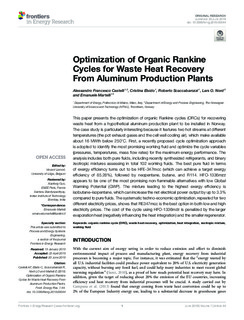| dc.contributor.author | Castelli, Alessandro Francesco | |
| dc.contributor.author | Elsido, Cristina | |
| dc.contributor.author | Scaccabarozzi, Roberto | |
| dc.contributor.author | Nord, Lars O. | |
| dc.contributor.author | Martelli, Emanuele | |
| dc.date.accessioned | 2019-06-24T14:38:16Z | |
| dc.date.available | 2019-06-24T14:38:16Z | |
| dc.date.created | 2019-06-24T09:55:51Z | |
| dc.date.issued | 2019 | |
| dc.identifier.issn | 2296-598X | |
| dc.identifier.uri | http://hdl.handle.net/11250/2601934 | |
| dc.description.abstract | This paper presents the optimization of organic Rankine cycles (ORCs) for recovering waste heat from a hypothetical aluminum production plant to be installed in Norway. The case study is particularly interesting because it features two hot streams at different temperatures (the pot exhaust gases and the cell wall cooling air), which make available about 16 MWth below 250°C. First, a recently proposed cycle optimization approach is adopted to identify the most promising working fluid and optimize the cycle variables (pressures, temperatures, mass flow rates) for the maximum energy performance. The analysis includes both pure fluids, including recently synthesized refrigerants, and binary zeotropic mixtures assessing in total 102 working fluids. The best pure fluid in terms of exergy efficiency turns out to be HFE-347mcc (which can achieve a target exergy efficiency of 85.28%), followed by neopentane, butane, and R114. HFO-1336mzz appears to be one of the most promising non-flammable alternatives with low Global Warming Potential (GWP). The mixture leading to the highest exergy efficiency is isobutane–isopentane, which can increase the net electrical power output by up to 3.3% compared to pure fluids. The systematic techno-economic optimization, repeated for two different electricity prices, shows that RE347mcc is the best option in both low and high electricity prices. The cost of the cycle using HFO-1336mzz is penalized by the larger evaporation heat (negatively influencing the heat integration) and the smaller regenerator. | nb_NO |
| dc.language.iso | eng | nb_NO |
| dc.publisher | Frontiers Media | nb_NO |
| dc.relation.uri | https://doi.org/10.3389/fenrg.2019.00044 | |
| dc.rights | Navngivelse 4.0 Internasjonal | * |
| dc.rights.uri | http://creativecommons.org/licenses/by/4.0/deed.no | * |
| dc.title | Optimization of Organic Rankine Cycles for Waste Heat Recovery From Aluminum Production Plants | nb_NO |
| dc.type | Journal article | nb_NO |
| dc.type | Peer reviewed | nb_NO |
| dc.description.version | publishedVersion | nb_NO |
| dc.source.volume | 7 | nb_NO |
| dc.source.journal | Frontiers in Energy Research | nb_NO |
| dc.identifier.doi | 10.3389/fenrg.2019.00044 | |
| dc.identifier.cristin | 1707149 | |
| dc.description.localcode | Copyright © 2019 Castelli, Elsido, Scaccabarozzi, Nord and Martelli. This is an open-access article distributed under the terms of the Creative Commons Attribution License (CC BY). | nb_NO |
| cristin.unitcode | 194,64,25,0 | |
| cristin.unitname | Institutt for energi- og prosessteknikk | |
| cristin.ispublished | true | |
| cristin.fulltext | original | |
| cristin.qualitycode | 1 | |

